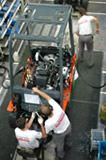JIDOKA: THE STEPS
Alberto Luci

Characters: small | medium | big
The steps to use Jidoka are:
- Identify and acknowledge the existence of the blockage, detect the abnormality. This first step can be mechanized or automated. Poka-yoke devices are one method to allow a process to detect a problem and stop.
Detecting an abnormal condition does no good, though, unless there is follow-up. Visual controls are just decoration unless they trigger action. - Stop. The second step can also be mechanized or automated. The underlying mental model is “don’t ship junk!”, versus mass production’s “make your numbers! We can fix them later”.
Production is interrupted as soon as an imperfection is detected.
A lot of people have a hard time with this because they think it means bringing all production to a grinding halt until the problem is resolved. Depending on the nature of the problem, sometimes it does. But stop is frequently simply a mental shift. It means "stop doing what you were doing because you need to do something different" It is an acknowledgement that some kind of intervention is required. That might mean shutting down a process or machine, or it might mean signaling for assistance
The third and fourth steps cannot be automated. They are entirely the domain of people because they require diagnosis, analysis and problem solving.
- Fix or correct the immediate condition. Remove the immediate blockage as quickly as possible, to get value flowing through the process again.
Any abnormality is directly solved and constitutes an opportunity for learning how to make things better - Investigate the root cause and install a countermeasure. Allocate some slack time to preventing the same class of problem recurring. Begin with a root-cause analysis, using the 5-whys technique if necessary. Discuss ways in which one or more of these root-causes could be eliminated. Then form one or more kaizen pairs as required to implement the process changes
